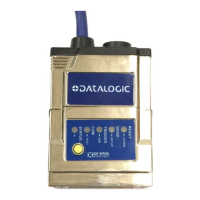MATRIX 210N™ REFERENCE MANUAL
5.5 ID-NET MULTIDATA NETWORK (PASS-THROUGH)
A special case of the pass-through layout allows each Slave device working Alone, to
collect data from one or more pass-through input channels and send this data plus its own on
the ID-NET output channel to the Master.
The Slave readers are connected together using the ID-NET interface. Every Slave reader
must have an ID-NET address in the range 1-31.
The Master collects the data from its pass-through ID-NET input channel and sends it to the
Host on a different output channel.
Figure 67 – (Pass-through) ID-NET Multidata Layout
In a Pass-through layout each device supports multiple pass-through configurations to accept
input from different devices on different channels (i.e. Master reader above). However, ID-NET
Slave readers are not required to have a pass-through configuration if they don’t need to
receive data from an input channel (i.e. right reader above). The ID-NET Master always has
at least one pass-through configuration to collect the ID-NET Slaves data and send it to the
Host.
NOTE: Slave devices cannot receive data from a pass-through ID-NET input
channel and Master devices cannot send data on an ID-NET output channel.
All devices always support multiple output channels (i.e. for data monitoring).
In a Pass-through layout each device can have a different operating mode: Continuous, One
Shot, Phase Mode, etc.
= Ethernet TCP/IP Server 1
= ID-NET (up to 32 devices, max network extension of 1000 m)
= Main Serial Interface (RS232 or RS422 Full-Duplex)
= Aux Serial Interface (RS232)
= Pass-through Input channel
= Output channel

